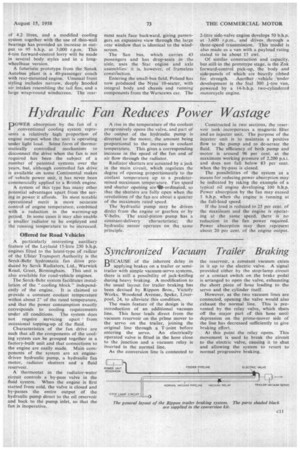Hydraulic Fan Reduces Power Wastage
Page 49

If you've noticed an error in this article please click here to report it so we can fix it.
DOWER absorption by the fan of a conventional cooling system represents a relatively high proportion of engine output when the unit is operating under light load. Some form of thermostatically controlled mechanism to disconnect the drive when the fan is not required has been the subject of a number of patented systems over the years, but, although controlled fan drive is available on some Continental makes of vehicle power unit, it has never been comthercially applied to a British engine.
A system of this type has many other potential advantages apart from the saving in power it affords, Its most notable operational merit is . more accurate control of engine temperature, combined with a reduction in the warming-up period. In some cases it may also enable a smaller radiator to be employed and the running temperature to he increased.
Offered for Road Vehicles
A particularly interesting auxiliary feature of the Leylarid 15-litre 230 b.h.p. engines fitted to the latest-type of railcar of the Ulster Transport Authority is the Serck-Behr hydrostatic fan drive produced by Serck Radiators, Ltd., Warwick Road, Greet, Birmingham. This unit is also available for road-vehicle engines.
The Serck-Behr system facilitates installation of the." cooling block" independ
ently of the engine. It is claimed to provide a constant -coolant temperature within about 2° of the rated temperature, and that the power consumption exactly corresponds to cooling requirements under all conditions. The system does not require servicing apart ' from occasional topping-up of the fluid.
Characteristics of the fan drive are such that all the components of the cooling system can be grouped together in a factory-built unit and that connections to the engine are easily made. Main components of the system are an enginedriven hydraulic pump, a hydraulic fan motor, radiator shutters and a fluid reservoir.
A' thermostat in the radiator-water circuit controls a by-pass valve in the fluid system. When the engine is first started from cold, the valve is closed and by-passes the entire output of the hydraulic pump direct to the oil reservoir and back to the pump inlet, so that the fan is inoperative. A rise in the temperature of the coolant progressively opens the valve, and part of the output of the hydraulic pump is diverted to the motor, the amount being proportional to the increase in coolant temperature. This gives a corresponding increase in the speed of the fan and of air flow through the radiator.
Radiator shutters are actuated by a jack in the main circuit, which regulates the degree of opening proportionately to the coolant temperature up to a predetermined maximum temperature. Fan speed and shutter opening are*-ordinated, so that the shutters are fully open when the revolutions of the fan are about a quarter of the maxinium rated speed.
The hydraulic pump may be driven direct from the engine or gearbox or by V-belts; The axial-piston • pump has a constant-delivery characteristic; the hydraulic motor operates on the same principle. Constructed in two sections, the reservoir tank incorporates a magnetic filter and an injector unit. The purpose of the injector unit is to maintain a positive flow to the pump and to de-aerate the fluid. The efficiency of both pump and motor is around 96 per cent, at the maximum working pressure of 2,200 p.s.i. and does not fall below 83 per cent. when the by-pass is closed.
The possibilities of the System as a means for reducing power absorption may be indicated by taking the example of a typical oil engine developing 100 b.h.p. Power absorption by the fan may exceed 5 b.h.p, when the engine is running at the full-load speed.
If the load is reduced to 25 per cent. of the maximum and the engine is operating at • the same speed, there is no reduction in the fan power required. Power absorption may then represent about 20 per cent. of the engine output.












































































































